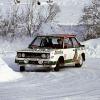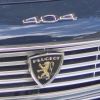Yes - I agree that if a fully-developed car had appeared as early as 64 or 65 it may have stood a chance. As it was, the first V12 wasn't assembled and placed on a test-bed until July 1964. The first V12 didn't actually run on the road in a car until April 1965 (albeit in a Mk10 Jaguar because the XJ13 was nowhere near being ready). At this stage, in early 1965, perhaps the 1966 Le Mans could have seemed a realistic target? Unfortunately, the XJ13 wasn't ready to receive an engine until March 1966- even though construction had commenced in 1965 - clearly too late for a realistic 1966 Le Mans entry. The emphasis at the time would have been on 1967. I have unconfirmed reports that Jaguar provisionally entered THREE cars in the 1967 race but I have yet to track down any documented proof of this.
While the XJ13 was being constructed, Jaguar acquired a GT40 for comparison and, with the benefit of this comparison, still decided it was worth pressing on with their own car. I am away from home at the moment so can't access my copy of an original internal Jaguar report which compares the XJ13 against its main opposition - largely in terms of power to weight ratio. The report concluded that a competitive XJ13 was achievable (but they would say that wouldn't they!). On my return home I will dig it out and see if it sheds any more light.
If Jaguar acquired a GT40, I suspect it was powered by a 289 V8, rather than the 7L unit employed by the LeMans MK-II and later MK-IV. The difference in HP would have altered the P/W analysis.
In 67, Jaguar would have competed against the Ford MK-IV and 330P4. The MK-IV was a completely new car, incorporating all of the lessons learned from the GT40 and MKII. The 330P4 was an evolution of the P2-P3 and very nearly as fast as the MK-IV at LeMans. At other tracks the P4 was arguably the better car. By 67 the XJ13 was a 2-3yr old design that would have given up 100hp to the MK-IV and probably 50hp to the P4. I have no doubt that the XJ13 would have handled well and appeared with fully sorted aerodynamics, but if 67 was the more realistic target date, it would have been uncompetitive on arrival no matter which top driver was employed (Clark, Hill, Stewart ????).
In a way it reminds me of the Aston Martin DBR-5 front engine GP machine. Had it appeared when designed or a year later (57 or 58) it would have been competitive. When it finally appeared in 59 it was obsolete.
I would be interested to read whatever documents you can post and we should all be grateful for your efforts in reconstructing an XJ13.
Best,
Ross























